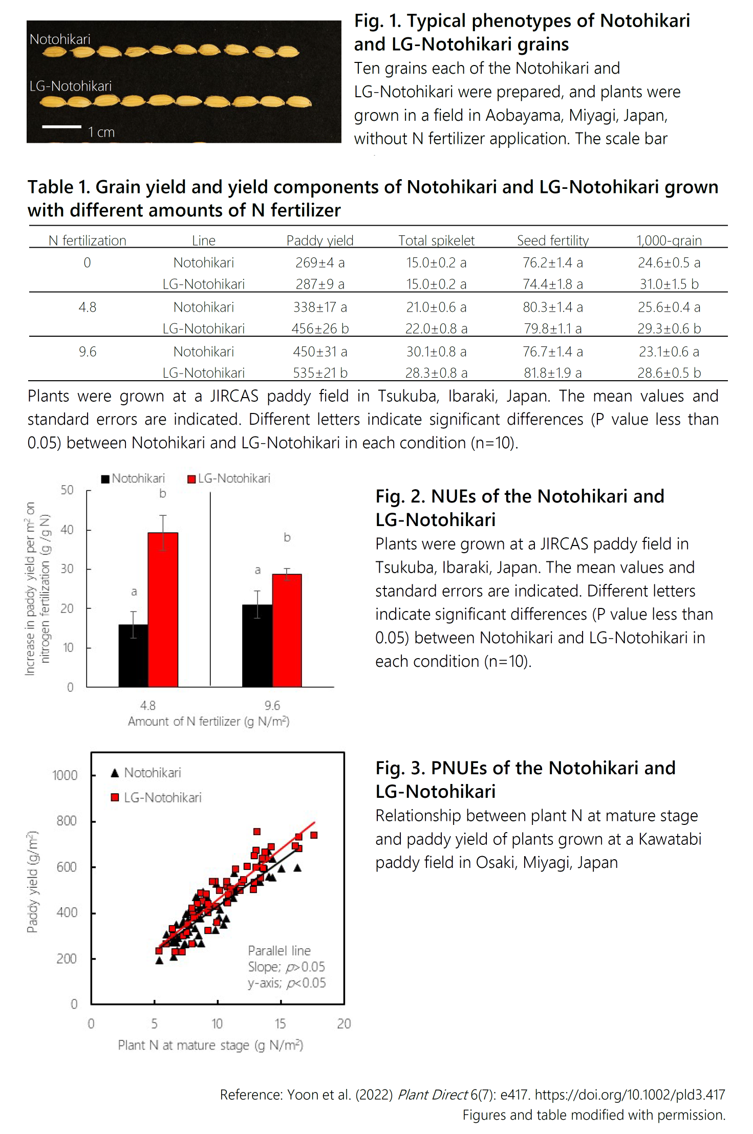Enlargement of grain size improves nitrogen utilization efficiency in rice
Description
The Green Revolution made it possible to increase crop yields through the application of large amounts of nitrogen (N) fertilizers, but it also resulted in serious environmental pollution. In addition, such production systems are vulnerable to high N fertilizer prices. Therefore, toward sustainable production and supply of rice, increasing the crop grain yield must be achieved without such a considerable input of N fertilization. Our previous studies demonstrated that a large-grain japonica rice cultivar, Akita 63, has high nitrogen utilization efficiency per unit of absorbed nitrogen (PNUE) and a large-grain allele of the GS3 gene. To examine the positive effect of the large-grain allele of GS3 on rice yields, PNUE, and nitrogen utilization efficiency per unit of fed nitrogen fertilizer (NUE), a near-isogenic line of the large-grain allele of GS3 originated from Akita 63 was developed in the genetic background of a japonica cultivar, Notohikari, with a large grain (LG-Notohikari).
LG-Notohikari always showed longer and wider grains compared to Notohikari in any fertilizer conditions (Fig. 1). Significant grain yield increases for LG-Notohikari were observed in two fertilized plots, with application rates equal to 4.8 and 9.6 g N/m2, but not observed in the unfertilized plot (Table 1). Among yield components, thousand-grain weight showed significant increases in all conditions tested. Also, grain yield of the LG-Notohikari grown in the 4.8 g N/m2 plot was similar to that of the Notohikari grown in the 9.6 g N/m2 plot. NUEs of the LG-Notohikari were significantly higher than those of the Notohikari in both N applications (Fig. 2). Likewise, PNUE of the LG-Notohikari was higher than that of the Notohikari (Fig. 3).
Enlargement of grain size using the large allele of GS3 improves nitrogen utilization efficiency in rice and can be used in a rice breeding program for reduced amounts of N fertilizer. It should be noted that the effect of improving NUE and grain quality by the enlargement of grain size depends on original varieties, growth conditions, environments, and other factors.
Figure, table
- Research project
- Program name
- KAKEN
- Term of research
-
FY2016–2022
- Responsible researcher
-
Obara Mitsuhiro ( Biological Resources and Post-harvest Division )
Yoon Dong-Kyung ( Tohoku University )
Ishiyama Keiki ( Tohoku University )
ORCID ID0000-0001-9259-1271KAKEN Researcher No.: 70360493Makino Amane ( Tohoku University )
KAKEN Researcher No.: 70181617 - ほか
- Publication, etc.
-
Yoon et al. (2022) Plant Direct 6(7): e417.https://doi.org/10.1002/pld3.417
- Japanese PDF
-
2022_B02_ja.pdf708.27 KB
- English PDF
-
2022_B02_en.pdf526.77 KB
* Affiliation at the time of implementation of the study.

